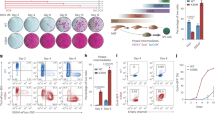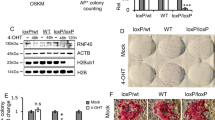Abstract
We identify LSD1 (lysine-specific demethylase 1; also known as KDM1A and AOF2) as a key histone modifier that participates in the maintenance of pluripotency through the regulation of bivalent domains, a chromatin environment present at the regulatory regions of developmental genes that contains both H3K4 di/trimethylation and H3K27 trimethylation marks. LSD1 occupies the promoters of a subset of developmental genes that contain bivalent domains and are co-occupied by OCT4 and NANOG in human embryonic stem cells, where it controls the levels of H3K4 methylation through its demethylase activity. Thus, LSD1 has a role in maintaining the silencing of several developmental genes in human embryonic stem cells by regulating the critical balance between H3K4 and H3K27 methylation at their regulatory regions.
This is a preview of subscription content, access via your institution
Access options
Subscribe to this journal
Receive 12 print issues and online access
$209.00 per year
only $17.42 per issue
Buy this article
- Purchase on Springer Link
- Instant access to full article PDF
Prices may be subject to local taxes which are calculated during checkout







Similar content being viewed by others
References
Azuara, V. et al. Chromatin signatures of pluripotent cell lines. Nat. Cell Biol. 8, 532–538 (2006).
Bernstein, B. E. et al. A bivalent chromatin structure marks key developmental genes in embryonic stem cells. Cell 125, 315–326 (2006).
Pan, G. et al. Whole-genome analysis of histone H3 lysine 4 and lysine 27 methylation in human embryonic stem cells. Cell Stem Cell 1, 299–312 (2007).
Zhao, X. et al. Whole-genome mapping of histone H3 Lys4 and 27 trimethylations reveals distinct genomic compartments in human embryonic stem cells. Cell Stem Cell 1, 286–298 (2007).
Boyer, L. A. et al. Polycomb complexes repress developmental regulators in murine embryonic stem cells. Nature 441, 349–353 (2006).
Lee, T. I. et al. Control of developmental regulators by Polycomb in human embryonic stem cells. Cell 125, 301–313 (2006).
Stock, J. K. et al. Ring1-mediated ubiquitination of H2A restrains poised RNA polymerase II at bivalent genes in mouse ES cells. Nat. Cell Biol. 9, 1428–1435 (2007).
Agger, K. et al. UTX and JMJD3 are histone H3K27 demethylases involved in HOX gene regulation and development. Nature 449, 731–734 (2007).
Boyer, L. A. et al. Core transcriptional regulatory circuitry in human embryonic stem cells. Cell 122, 947–956 (2005).
Pardo, M. et al. An expanded Oct4 interaction network: implications for stem cell biology, development, and disease. Cell Stem Cell 6, 382–395 (2010).
Wang, J. et al. A protein interaction network for pluripotency of embryonic stem cells. Nature 444, 364–368 (2006).
Shi, Y. et al. Histone demethylation mediated by the nuclear amine oxidase homolog LSD1. Cell 119, 941–953 (2004).
Ballas, N. et al. Regulation of neuronal traits by a novel transcriptional complex. Neuron 31, 353–365 (2001).
Wang, Y. et al. LSD1 is a subunit of the NuRD complex and targets the metastasis programs in breast cancer. Cell 138, 660–672 (2009).
Metzger, E. et al. LSD1 demethylates repressive histone marks to promote androgen-receptor-dependent transcription. Nature 437, 436–439 (2005).
Wissmann, M. et al. Cooperative demethylation by JMJD2C and LSD1 promotes androgen receptor-dependent gene expression. Nat. Cell Biol. 9, 347–353 (2007).
Huang, J. et al. p53 is regulated by the lysine demethylase LSD1. Nature 449, 105–108 (2007).
Wang, J. et al. The lysine demethylase LSD1 (KDM1) is required for maintenance of global DNA methylation. Nat. Genet. 41, 125–129 (2009).
Kontaki, H. & Talianidis, I. Lysine methylation regulates E2F1-induced cell death. Mol. Cell. 39, 152–160 (2010).
Raya, A. et al. Generation of cardiomyocytes from new human embryonic stem cell lines derived from poor-quality blastocysts. Cold Spring Harb. Symp. Quant. Biol. 73, 127–135 (2008).
Lee, M. G., Wynder, C., Cooch, N. & Shiekhattar, R. An essential role forCoREST in nucleosomal histone 3 lysine 4 demethylation. Nature 437, 432–435 (2005).
Ku, M. et al. Genome-wide analysis of PRC1 and PRC2 occupancy identifies two classes of bivalent domains. PLoS Genet. 4, e1000242 (2008).
Bruce, A. W. et al. Genome-wide analysis of repressor element 1 silencing transcription factor/neuron-restrictive silencing factor (REST/NRSF) target genes. Proc. Natl Acad. Sci. USA 101, 10458–10463 (2004).
Niakan, K. K. et al. Sox17 promotes differentiation in mouse embryonic stem cells by directly regulating extraembryonic gene expression and indirectly antagonizing self-renewal. Genes Dev. 24, 312–326 (2010).
Seguin, C. A., Draper, J. S., Nagy, A. & Rossant, J. Establishment of endoderm progenitors by SOX transcription factor expression in human embryonic stem cells. Cell Stem Cell 3, 182–195 (2008).
Buckley, N. J., Johnson, R., Sun, Y. M. & Stanton, L. W. Is REST a regulator of pluripotency? Nature 457, E5-6; discussion E7 (2009).
Jorgensen, H. F., Chen, Z. F., Merkenschlager, M. & Fisher, A. G. Is REST required for ESC pluripotency? Nature 457 E4-5; discussion E7 (2009).
Yamada, Y., Aoki, H., Kunisada, T. & Hara, A. Rest promotes the early differentiation of mouse ESCs but is not required for their maintenance. Cell Stem Cell 6, 10–15 (2010).
Liang, J. et al. Nanog and Oct4 associate with unique transcriptional repression complexes in embryonic stem cells. Nat. Cell Biol 10, 731–739 (2008).
van den Berg, D. L. et al. An Oct4-centred protein interaction network in embryonic stem cells. Cell Stem Cell 6, 369–381 (2010).
Tsai, M. C. et al. Long noncoding RNA as modular scaffold of histone modification complexes. Science 329, 689–693 (2010).
Foster, C. T. et al. Lysine-specific demethylase 1 regulates the embryonic transcriptome and CoREST stability. Mol. Cell. Biol. 30, 4851–4863 (2010).
Macfarlan, T. S. et al. Endogenous retroviruses and neighboring genes are coordinately repressed by LSD1/KDM1A. Genes Dev. (2011).
de la Cruz, C. C. et al. Developmental regulation of Suz 12 localization. Chromosoma 114, 183–192 (2005).
Greco, S. J., Smirnov, S. V., Murthy, R. G. & Rameshwar, P. Synergy between the RE-1 silencer of transcription and NFκB in the repression of the neurotransmitter gene TAC1 in human mesenchymal stem cells. J. Biol. Chem. 282, 30039–30050 (2007).
Wiznerowicz, M. & Trono, D. Conditional suppression of cellular genes: lentivirus vector-mediated drug-inducible RNA interference. J. Virol. 77, 8957–8961 (2003).
Pratt, T., Sharp, L., Nichols, J., Price, D. J. & Mason, J. O. Embryonic stem cells and transgenic mice ubiquitously expressing a tau-tagged green fluorescent protein. Dev. Biol. 228, 19–28 (2000).
Ritchie, M. E. et al. A comparison of background correction methods for two-colour microarrays. Bioinformatics 23, 2700–2707 (2007).
Smyth, G. K. Linear models and empirical Bayes methods for assessing differential expression in microarray experiments. Stat. Appl. Genetics Mol. Biol. 3,1–26 Article3 (2004).
Benjamini, Y. & Hochberg, Y. Controlling the false discovery rate: a practical and powerful approach to multiple testing. J. R. Stat. Soc. B 1, 289–300 (1995).
Gentleman, R. C. et al. Bioconductor: open software development for computational biology and bioinformatics. Genome Biol. 5, R80 (2004).
Rosenbloom, K. R. et al. ENCODE whole-genome data in the UCSC Genome Browser. Nucleic Acids Res. 38, D620–D625 (2010).
Huang da, W., Sherman, B. T. & Lempicki, R. A. Systematic and integrative analysis of large gene lists using DAVID bioinformatics resources. Nat. Protocols 4, 44–57 (2009).
Acknowledgements
We thank S. Malik and I. Martinez for critical reading of the manuscript, D. Trono for plasmids pLVTHM and psPAX2, T. Pratt for plasmid pTP6, A. Consiglio for assistance with viral preparations and infection, R. Vassena, I. Rodriguez and A. Sanchez for help with the differentiation experiments, B. Christen for advice on cell treatments and V. Astro for assistance with movie preparation. M.J.B. was partially supported by the Ramón y Cajal programme. B.S. is a predoctoral fellow from the Ministerio de Ciencia e Innovación of Spain. This work was partially supported by grants RYC-2007-01510 and SAF2009-08588 from the Ministerio de Ciencia e Innovación of Spain to M.J.B. and grants from the G. Harold and Leila Y. Mathers Charitable Foundation, Sanofi-Aventis, MICINN, CIBER and Fundacion Cellex to J.C.I.B.
Author information
Authors and Affiliations
Contributions
A.A. set up techniques, designed and carried out the experiments with the assistance of B.S., J.C. and M.J.B. and wrote the paper. S.B. and I.P. carried out the bioinformatics analysis. M.J.B. conceived and supervised the project and wrote the paper. J.C.I.B. supervised the project and wrote the paper.
Corresponding author
Ethics declarations
Competing interests
The authors declare no competing financial interests.
Supplementary information
Supplementary Information
Supplementary Information (PDF 1054 kb)
Supplementary Information
Supplementary Movie 1 (MOV 4835 kb)
Supplementary Information
Supplementary Movie 2 (MOV 5025 kb)
Supplementary Information
Supplementary Table 1 (XLS 179 kb)
Supplementary Information
Supplementary Table 2 (XLS 140 kb)
Supplementary Information
Supplementary Table 3 (XLS 102 kb)
Supplementary Information
Supplementary Table 4 (XLS 10028 kb)
Supplementary Information
Supplementary Table 5 (XLS 31 kb)
Rights and permissions
About this article
Cite this article
Adamo, A., Sesé, B., Boue, S. et al. LSD1 regulates the balance between self-renewal and differentiation in human embryonic stem cells. Nat Cell Biol 13, 652–659 (2011). https://doi.org/10.1038/ncb2246
Received:
Accepted:
Published:
Issue Date:
DOI: https://doi.org/10.1038/ncb2246
This article is cited by
-
Pan-cancer analysis revealed H3K4me1 at bivalent promoters premarks DNA hypermethylation during tumor development and identified the regulatory role of DNA methylation in relation to histone modifications
BMC Genomics (2023)
-
Phosphoproteomic analysis on ovarian follicles reveals the involvement of LSD1 phosphorylation in Chicken follicle selection
BMC Genomics (2023)
-
Ubiquitin-specific protease 28: the decipherment of its dual roles in cancer development
Experimental Hematology & Oncology (2023)
-
PRC2 mediated KLF2 down regulation: a therapeutic and diagnostic axis during tumor progression
Cancer Cell International (2023)
-
Aggressive variants of prostate cancer: underlying mechanisms of neuroendocrine transdifferentiation
Journal of Experimental & Clinical Cancer Research (2022)



